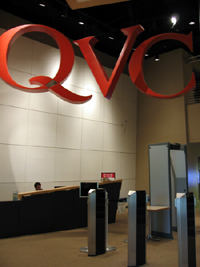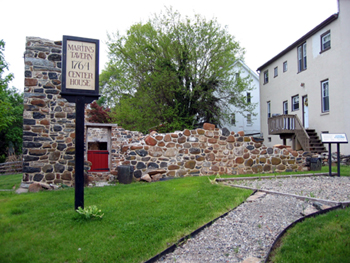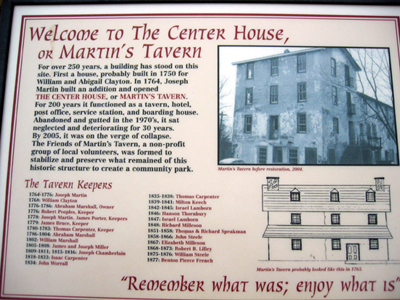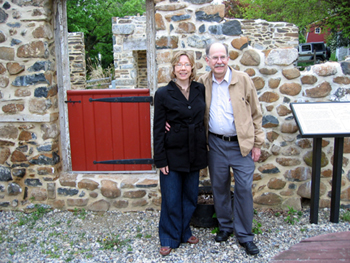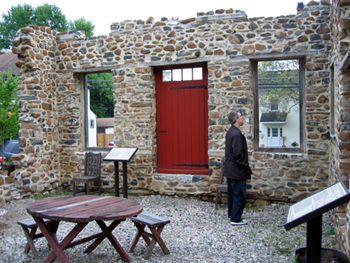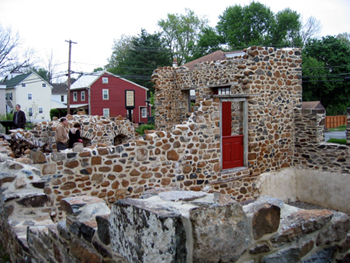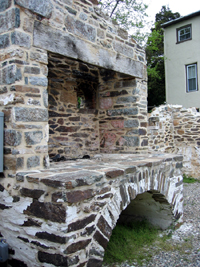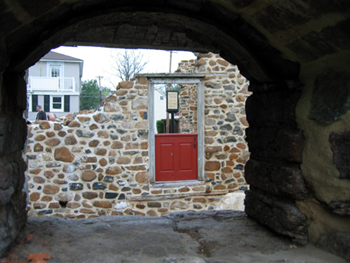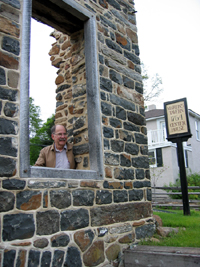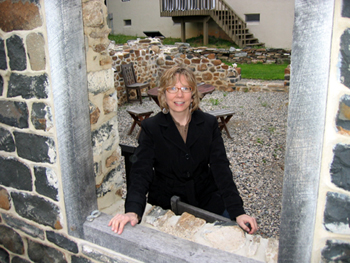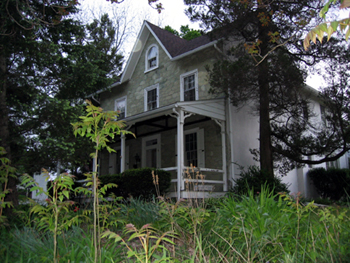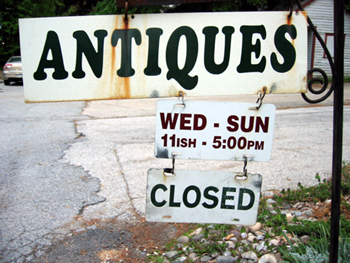Musings
an Online Journal of Sorts
By Alyce Wilson
May 6, 2008 - Inside QVC
Sign in the lobby
On Saturday, The Gryphon and I met Dad and The Adventurer at their hotel at 2 p.m., just after their last mandatory session ended at the medical convention.
The idea was to do something fun in the area. We discussed possibilities and decided on the QVC studio tour, which The Adventurer had taken with her mother several years ago but which none of the rest of us had done.
My Dad did the driving, using directions we'd pulled up on Mapquest that morning. It was a bright and sunny day but a little chilly for this time of year.
We arrived around 2:30, and the next tour was at 3, so we browsed the studio store. While a lot of the items looked interesting, I'm not in a position to buy frivolous things, not while The Gryphon is between jobs.
When the time came for our tour, we passed through the metal detector and a guard examined our bags. The tour guide told me I wouldn't be allowed to take any pictures during the tour.
We followed her up the stairs into a carpeted hallway lined with photographs relating to the network. As we walked, she told us some basic statistics about QVC, such as the fact that QVC employs approximately 17,279 people worldwide. Its Studio Park headquarters sits on 84 acres of land, roughly the size of 15 football fields. QVC has been in operation since 1986.
The first room we entered was a display room containing a wall full of pictures related to QVC. The guide played for us a short clip from the very first broadcast, which looked much different. They used to perform everything on a rather small change with three discrete sections to set up items. The backdrop was always the same: a wooden wall with shelves. The Adventurer, who watches QVC, recognized one of the hosts, who is still with the network.
Then the guide showed us some images of the on-air talent and told us some interesting facts about them, such as that one of them is a big animal lover and fosters animals at her home.
She also showed us some images of the traveling bus, which they used to use for remote broadcasts. It's been retired in favor of a semi, which serves as a rolling studio. After that, we watched a brief video about the different types of shows that have been on QVC. The products range from fashion and accessories to cooking and gardening tools to collectibles.
We followed her down a hallway lined with photos of the celebrities who have appeared on QVC. The celebs ranged from the music and entertainment industry to sports to business. She told us some additional facts about some of the celebrities, and we asked her questions. I asked her who the biggest selling celebrity at QVC was, and without hesitation, she said Joan Rivers. She said Rivers does a lot of work with them. From what I know about her reputation, she tends to be a hard worker and is tireless.
I mentioned that I'd seen that Paula Abdul did some work with them recently. I learned about it while watching her reality show. The guide remarked that Paula wasn't doing that anymore. I'm not surprised, given that on the reality show she proved herself to be difficult to work with, throwing a fit when she couldn't have her way.
Now we entered an area where we could see the studios. We were in a second floor hallway, looking down through double-paned glass, which I presume added sound proofing. Below us, we could see crew members setting up items for a shoot later that day. It appeared to be some sort of jewelry segment. The on-air talent was actually right below us but in front of a tall flat, which obscured our vision. We could see the red lights on the cameras blink on and off, however. Also, we could watch live monitors, which are everywhere throughout the building, and see what was happening on-air.
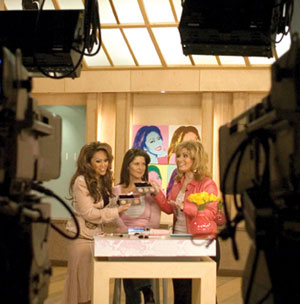
Mally
Roncal sells her Mally Beauty line
with a QVC model and QVC host, Patti Reilly.
(photo from Electronic
Retailer Mag)
I was struck by how massive the studio area was. They have about six or seven permanent sets, made to look like different parts of the house, like a garage, a patio, and several different interiors. Teams are constantly on the mood, setting up merchandise and arranging the set, including flats which the set department can paint to spec. They also have a number of different backgrounds for the different seasons that can be rotated to appear behind the fake windows and doors.
The whole process seems to be a 24-hour juggling performance: where something is always on-air, something else being set up, something else being struck. The on-air talent, we were told, have to arrive early depending on how long they'll be on camera. If they're doing a two-hour show, they have to be two hours early. If it's a three-hour show, three hours early. The guide said that allows them time to familiarize themselves with the products. They don't use TelePrompTers; the only information that appears on a monitor for them is the information on live callers.
I was fascinated by how many permanent lights hang from the ceiling, which was festooned with lights of various sizes and shapes. Of course, since the sets remain stable, they can keep the lights in place and use the ones that are appropriate for each shoot. I also imagine their needs are different than a typical TV show, because they want to light each product to full advantage.
We learned that some of the cameras are robotic, controlled remotely from the control booth. Actually, the entire time we were there, I don't believe we saw one camera being operated by a live person.
Next, we passed another, smaller studio, which is used by some of the celebrity guests, such as Joan Rivers. She's one of the few who has her own set, which is kept in storage for her and brought out for each appearance. In one corner of the room, they were setting up for a bath products shoot.
Then we walked by some control booths. One was empty. One contained a couple people who were preparing for an upcoming show, and the third was on-air. We could see about four people running it. One was doing graphics, another was probably running tape (they tape close-ups of the products ahead of time), another appeared to be handling the robotic cameras, and a fourth was likely the director, although the guide called him a supervisor. Another person was just sitting behind the director: perhaps a friend visiting or a new employee in training.
The wall contained a lot more video screens than we had in my days as a broadcast/cable major at Penn State. Our bare-bones studio only had a wall of about three or four screens. Theirs showed the different cameras available to them for this segment, as well as the cameras on the sets that weren't currently in use.
The crew seemed very relaxed, which I noticed throughout the building. Everybody seemed laid-back; there was no sense of urgency or panic. I got the feeling they were seasoned professionals, comfortable with their jobs. The average age of employee was about mid- to late 20s. I'd imagine a lot of broadcasting majors from places like Penn State take jobs there to get their start in the field.
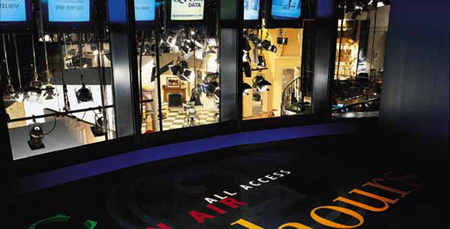
QVC Studios, photo by QVC (copyright 2002)
At this point, we got to walk out onto an observation deck from which we could see the studios from a different angle, inside the room where the action took place. On a raised platform on the opposite side of the booth (though there were no windows between them), about four or five people sat at computers. At first, I thought they were just chatting with each other, but then the guide told us they were screening callers who might want to comment or give testimonials on-air.
The guide pointed out another person at that station who was monitoring a computer with real-time sales figures. She said that if the sales completely bottomed out, they would cut the segment short and move to the next product.
We did not get lucky with timing, because we could not see the on-air talent from our location. She was on one of the further sets, off to our left. And again, we could see the robotic cameras, but she was blocked by a wing of the set. However, we could hear her voice live.
We saw some crew members setting up handbags below us, the same handbags we'd seen being photographed in one of the other rooms we'd passed.
Next, we passed the graphics department and got to see a young man hard to work on a simulation. The product was behind him, and he'd created what appeared to be an accurate rendering. It was a patio umbrella with solar-powered lights. He appeared to be working on an animation about its use.
Finally, we walked down a last hallway. It contained the quality control rooms, but no one was working. The quality control department tests products to make sure they're what they claim to be. For example, they might melt down random samplings of jewelry to evaluate whether it's made out of the advertised metals.
We also saw a few other studio spaces, including a functioning kitchen used for food demonstrations. They also have a false kitchen, which is used for other kitchen products that don't require cooking. The guide told us that Hulk Hogan had demonstrated a product recently, and she was amazed by how big he was. After he'd finished his product demo, he ate all the food he'd cooked and then went to another set and ate some of theirs!
We peered, as well, into the studio where they hold live audience shows for people like Paula Deen. The guide said that the tickets are free and available for a limited window. You can look for notices about them on the Web site.
At one point, we saw a graphic that depicted the entire process from product discovery to the show airing and distribution. There are quite a few stages along the way. No wonder they employ so many people.
I had a slight headache by the time we finished. I don't know if it had something to do with the building or with simply being dehydrated, since I hadn't had as much to drink as I usually do.
We stopped once more in the studio store. I bought a couple reusable nylon bags which fold up into small stuff sacks and can be stored in a purse, briefcase or car, wherever they might prove useful. The Adventurer bought a travel purse, which she'll use for some upcoming international trips. In addition to a zippered compartment, it has a pocked for a water bottle and another to stow your passport, I.D. and boarding pass for easy removal. It stays close to your body, with a wide strap for comfort.
I do regret not getting a picture of us in the lobby. While I was waiting for everyone to finish in the shop, I snapped a picture of the sign. But then a group of Cub Scouts filled up the lobby, so by the time we were ready to leave, it would have been difficult to get the shot I wanted.
We drove to downtown West Chester then for dinner, parking in a garage and walking down Gay Street, where many restaurants are located. We settled on Landmark Americana, a new restaurant which bills itself as a sports bar, upscale eatery and lounge rolled into one. We liked the selection of items on the menu.
I had the maple glazed salmon, as did The Adventurer. I loved it: sweetness offsetting the tender salmon. I couldn't eat all of it, though, so I had the rest boxed up. While we were eating, the Kentucky Derby race took place, and we could see it on the multiple TVs in the restaurant. However, they didn't have the closed captioning on, so we didn't know exactly what was happening, until they were clearly showing Big Brown's trainer, captioned, celebrating his victory.
We walked down to Sprazzo, a gelato, dolci and espresso bar, where we all ordered small gelatos. I got the hazlenut flavor, which was delicious. Creamy, nutty, and sweet taste. We savored our gelato, walking slowly back to the car. My Dad and The Adventurer were both impressed with how West Chester has been beautified and cleaned up in recent years, making it attractive to tourists and shoppers alike.
On the way back, my dad suggested we stop at the historic building which my great-great-great-grandfather, Abraham Marshall, had once run as a tavern. The building is just outside of West Chester in Marshallton, named after my Quaker ancestors, many of whom were named Marshall and lived there.
As we got closer, Dad told me that the last time he'd visited, several years ago, the building had been up for sale. However, he'd seen the shape it was in and decided he couldn't afford to either restore or maintain it. When we approached, we saw what we thought were ruins and were disappointed. But as we drew closer, we saw a nice sign and realized the building had been preserved in a unique way.
Instead of trying to restore the existing building, which had grown over the years into a three story boarding house in disrepair, they had torn down everything but the original walls, door frames and fireplaces. Those walls had been stabilized and repointed, and the area was turned into a community park, known as Martin's Tavern, after the original owner, Joseph Martin.
Throughout the site were signs giving the history of the building and its significance in the town. According to pictures in a brochure we collected from a box there, they also host events with colonial reenactors.
We explored the building and took several pictures.
The Friends of Martin's Tavern is seeking donations to support the perpetual care of this historic site. You can find out more at their Web site.
Dad wanted to show me one more site: the house where his great-aunts had lived. This was still in private hands, so we didn't stay long, but Dad and I walked up and looked. He was telling me they used to grow lots of flowers in the backyard, which was now just a grassy lawn, much to his disappointment. The current owners don't seem to be doing much with the property, but at least it isn't crumbling away.
Next door was a small antiques shop which may or may not be owned by the homeowners. I found the sign to be amusing in the casual designation of store hours.
Afterwards, we drove back to the hotel, where we bid them goodnight. It was their last night in town, and we thought they might want some time alone. The Gryphon and I headed home, making plans before we did to meet up with Dad the next day.
(Look for a write-up, to run Thursday or Friday, on our visit to the Frida Kahlo exhibit at the Philadelphia Museum of Art.)
Moral:
It takes a cast of thousands to produce a simple-looking show.
Copyright
2008 by Alyce Wilson
What
do you think? Share your thoughts
at Alyce's message board (left button):
![]()
![]()
